Article originally published on culturainrivera.it
Yes, you are right: there is not much point in writing a review of an exhibition after it has closed and therefore when it is no longer possible to go and visit it. My fault that I went to see it in depth just in the last few days, and that I didn’t find the time to write something earlier. Exhibitions, you know, are ephemeral creatures: they are not like movies that we can see even after they leave theaters’ schedules, and if you will, they are not even like plays for which accurate recordings often survive. No, once an exhibition closes all that remains of it is its memory: so you will want to forgive if this little article takes more the form of a remembrance of what the exhibition wanted to be and especially of the topics it wanted to divulge, as well as the form of a lengthy invitation to delve into the meanderings of the protagonist’s art.
Gianluca Lerici (La Spezia, 1963 - 2006), best known by his nickname, Prof. Bad Trip, was able to get everyone to agree: in the rooms of the Teké Gallery in Carrara we saw roaming around compulsorily adorned individuals mixed with punks and social center-goers, all of whom had come specifically to celebrate, in the tenth year of his passing, a character who of the underground counterculture has always been an important reference point. It may also have been because the exhibition had a pronounced popularizing orientation: obviously not at the levels of large gallery exhibitions in big cities (and given also the disparity of means it could not have been otherwise), but surely the exhibition A saucerful of colors, as far as its ability to popularize, to reach the public in a direct way and to take on, if you will, even didactic intentions, beat (and by a distance) all the official Marble Weeks exhibitions put together: let us hope that someone from the administration visited and took note. The Marble Weeks exhibitions are mostly high quality events, as I have already had occasion to write: but if their dissemination apparatus had been even similar to that of A saucerful of colors, the success with the public would probably have been far greater.
But let us talk about the works. The subversive charge of Prof. Bad Trip’s art is represented above all by the colors: full hues, strong and violent colors, electric and visionary colors that strike and overwhelm the observer, accompanying him, even if only by pretense, through that state of psycho-physical alteration typical of acid trips to which the very nickname chosen by Gianluca Lerici refers. With the addition of the affix “Professor” (because for some time he taught in a private high school in La Spezia) and the adjective bad, to indicate the more negative side of thelysergic experience: "badtrips because ... I’m quite a dystopian, I was burned out by the experience of the 1980s, by a certain kind of pessimistic music and literature about the future“ and because ”the social reality we live in is not that it’s too funny," as he had to declare in 1993 in an interview easily found on YouTube. The visions take various forms: there is a psychotropic Aquarium where a disturbing fish swims among greenish waters and anemones with tentacles that seem to want to grab it. There are Acid Flowers that seem to come straight out of hallucinated apparitions. There can be no shortage of interstellar travel, including comets, asteroids, spaceships and space monsters. And to make the works even more hallucinatory, the exhibition organizers provided anaglyph 3D glasses to get as close as possible to the acid visions: colors changing and blending, lines dancing, disturbed visuals.
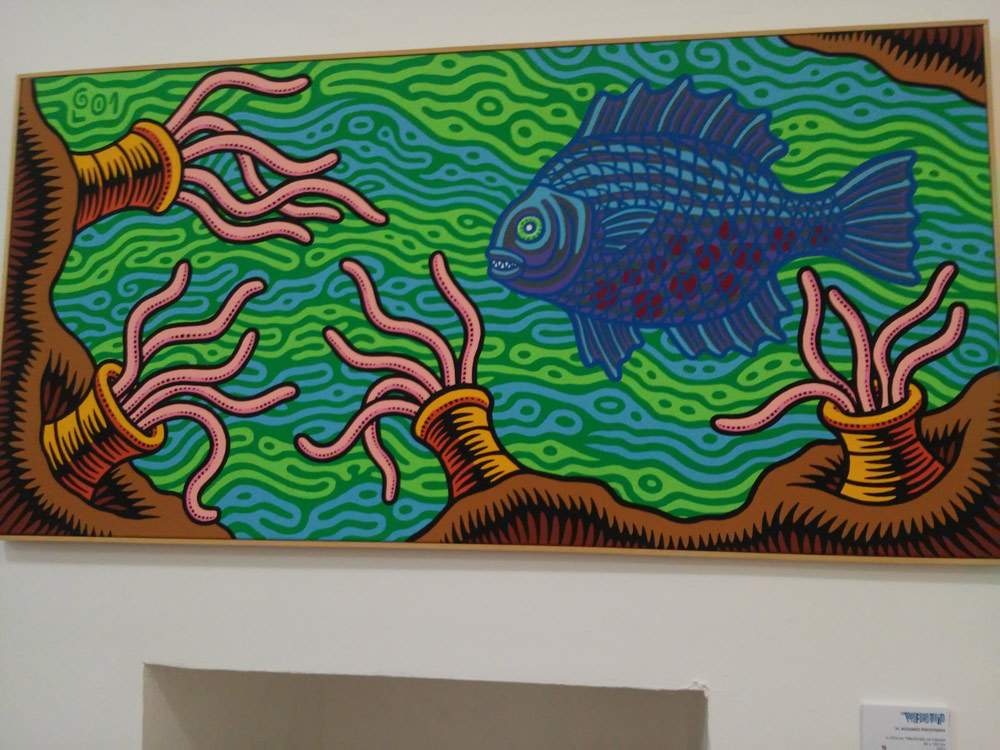 |
| Prof. Bad Trip, “Psychotropic Aquarium” (2001; acrylic on canvas, 100 x 50 cm) |
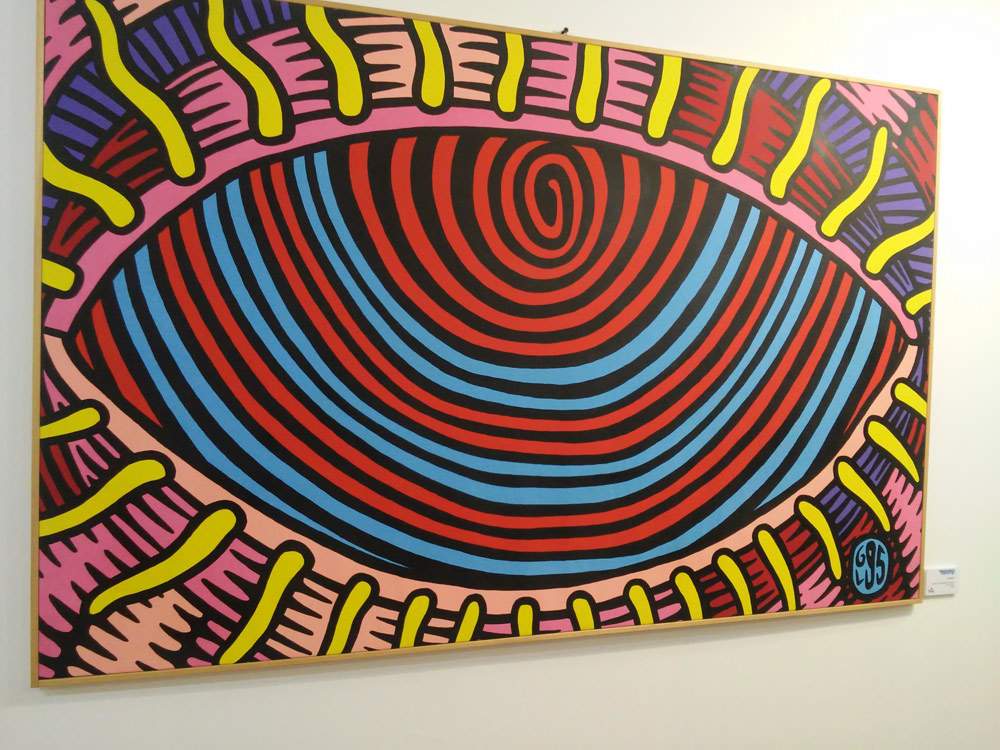 |
| Prof. Bad Trip, “Bad Eye” (1995; acrylic on canvas, 147 x 95 cm) |
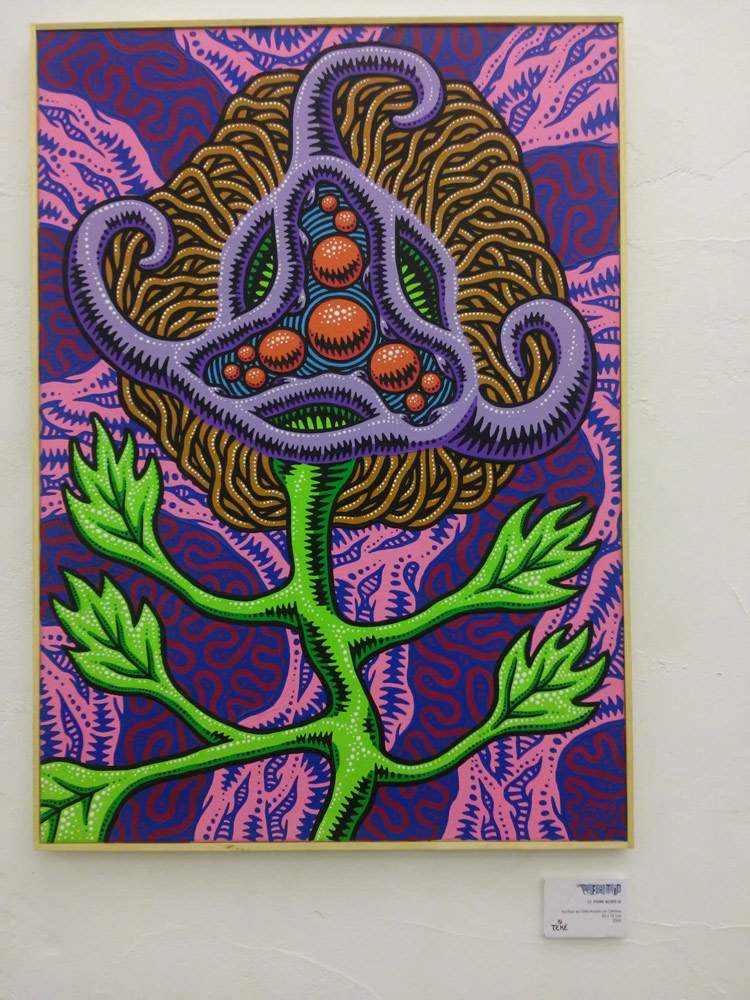 |
| Prof. Bad Trip, "Acid Flower IV" (2006; acrylic on canvas, 50 x 70 cm |
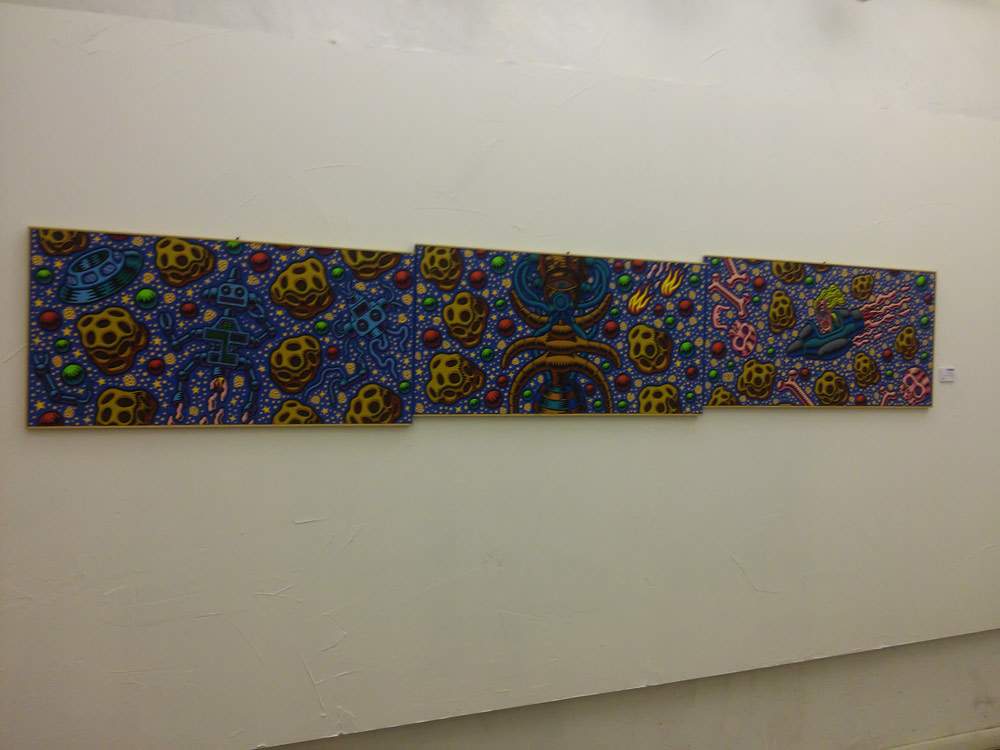 |
| Prof. Bad Trip, “Space Triptych” (2001; three acrylics on canvas, 50 x 100 cm |
However, there is also a strong attachment to reality in Gianluca Lerici’s art, an attachment to reality that expresses itself in the form of a strong, direct social critique that takes a stable position (although the Professor was speaking of a poetic position, rather than a political position). It was the professor himself who stated, in the so-called “Apocalyptic Interview” given to the artist and music critic Vittore Baroni and published posthumously in the exhibition catalog, what the “ingredients” were that formed his way of seeing reality: “tribal art of every era; history of so-called utopian ideas, from Proudon, Bakunin, Marx to the present day; Dadaism and expressionism; pre-Columbian art; dystopian literature: George Orwell, Aldous Huxley and Ray Bradbury; experimental, hallucinatory and pre-cyber literature (William S. Burroughs, J.G. Ballard, and Philip K. Dick); pataphysics, from Alfred Jarry to the Church of the SubGenius; art brut; libertarian cinema, from Luis Buñuel to Stanley Kubrick; fanta-psycho cinema (Ridley Scott, David Cronenberg, John Carpenter).”
Perhaps the most direct homage in the exhibition to his ideas is the Portrait of Gogliardo Fiaschi, the anarchist, the partisan who fought against the fascists in Italy during the Resistance and in Spain during Francoism by organizing an assassination attempt that later failed against the Caudillo, and the founder of the Circolo Culturale Anarchico of Carrara. Lerici portrays him with a proud gaze pointing straight at the viewer’s eyes, with a lavallière tie around his neck, and with a heart and an “A” circled in the upper corners of the composition. A portrait that is a clear tribute toanarchy, but also to the city of Carrara to which Gianluca Lerici was intimately linked: it was here that he first attended the Liceo Artistico and then the Accademia di Belle Arti, where he graduated in 1988, it was here that in the 1990s he opened a workshop where his silkscreens were printed, it was here that he could be seen attending the Circolo Culturale, or anarchist parties. Frequentations that, among other things, provided the Professor with cues for his art: some of the characters he met at concerts, in anarchist circles, in clubs, became the protagonists of a poster, Amarcord ’80, among the most interesting works in the exhibition. Because it is capable of evoking an era and, above all, a scene of which many of the visitors to the exhibition (including us) could only hear about from those who were there, due to mere age limits.
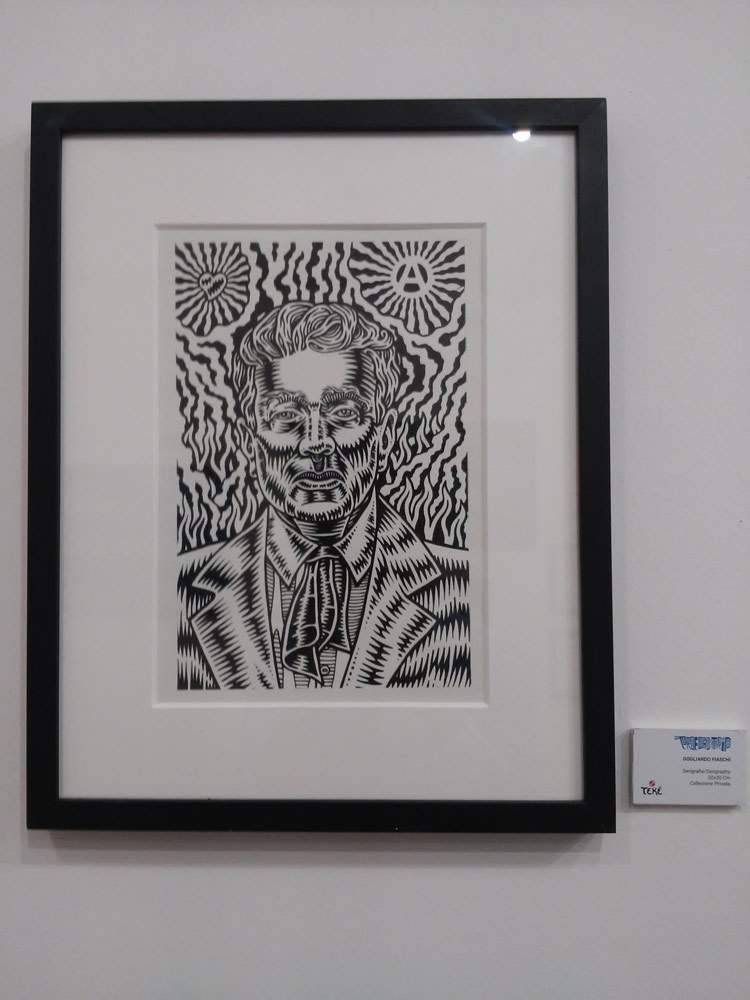 |
| Prof. Bad Trip, Portrait of Gogliardo Fiaschi (silkscreen print, 20 x 30 cm; private collection) |
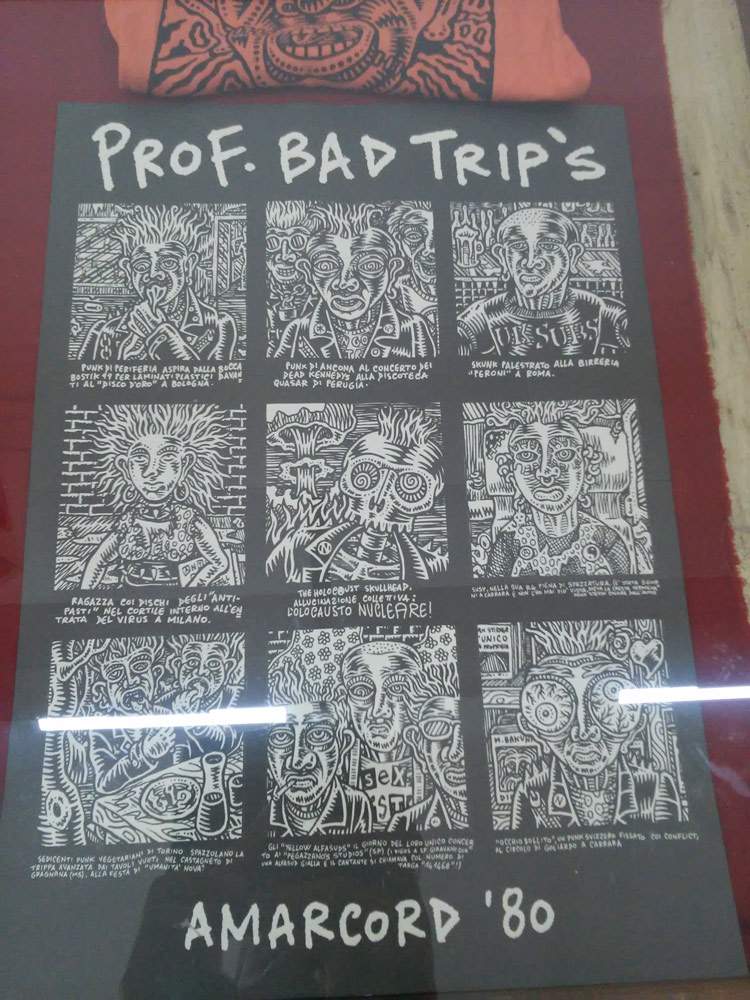 |
| Prof. Bad Trip, “Amarcord ’80” |
For those who were not there, all that remains is to observe the works, and perhaps to listen to the testimonies of those who knew the Professor and lived with him the same period with all its load of anguish but, at the same time, also positivity, because in any case Gianluca Lerici had a basically positive vision of the future: “every pop-underground artist is like an amanita muscaria, it releases cultural spores ready to flourish again perhaps years or miles away.” It was said that Prof. Bad Trip’s production is strongly rooted in reality. Many of his works depict recurring nightmares of society, beginning with perhaps the most frequent in his art, that of out-of-control technology taking the form of menacing robots, but also that of an oppressive state ready to condition people through the distorted use of those who should be the guardians of order: very powerful in this sense is Greetings from Genoa, a work in which, against a backdrop of red flames, a celerino is depicted as a kind of large insect-robot fully armed and with a mask entirely covering his face to conceal his identity (the reference to the torturing policemen who in the days of the 2001 G8 summit raged with unspeakable, useless and cowardly violence on dozens of boys between Albaro, at the Diaz school, and Bolzaneto, and who have gone essentially unpunished, is obvious: the painting dates from the following year). These visions are expressed in all sorts of media and techniques: paintings, sculptures, prints, comics, but also t-shirts and stamps.
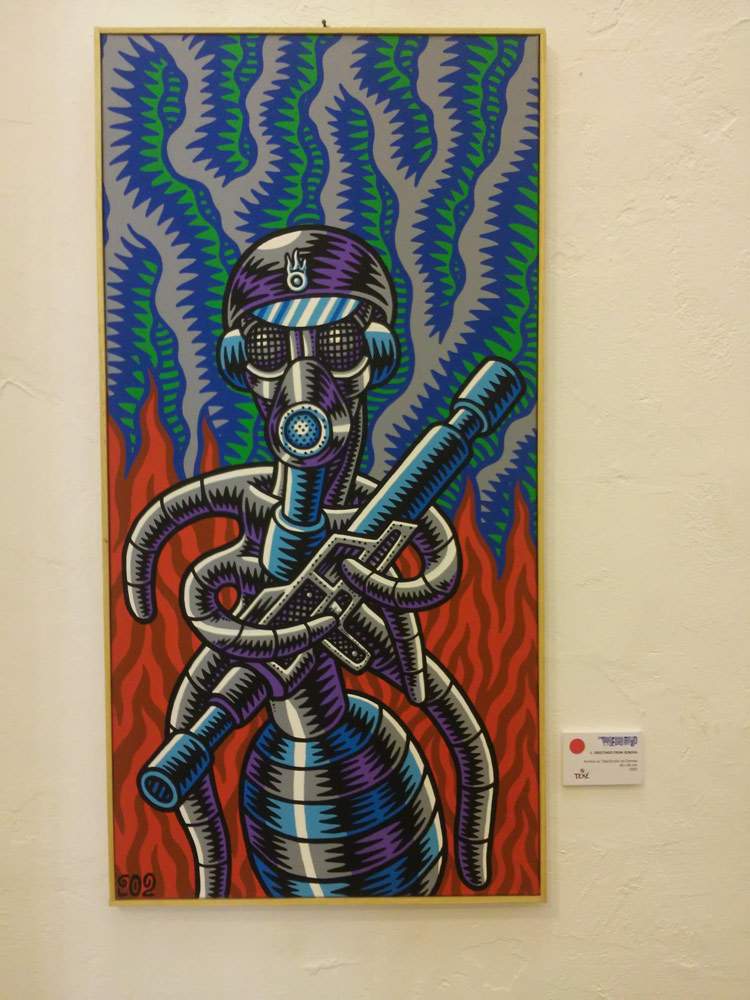 |
| Prof. Bad Trip, “Greetings from Genoa” (2002; acrylic on canvas, 40 x 80 cm) |
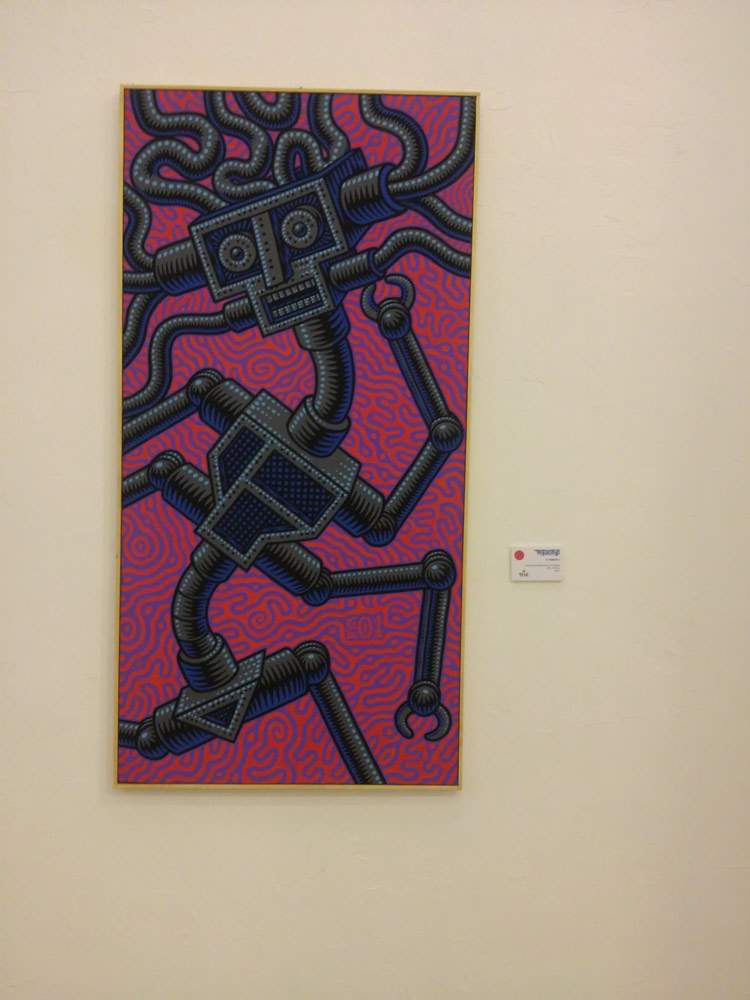 |
| Prof. Bad Trip, “Robota II” (2001; acrylic on canvas, 50 x 100 cm |
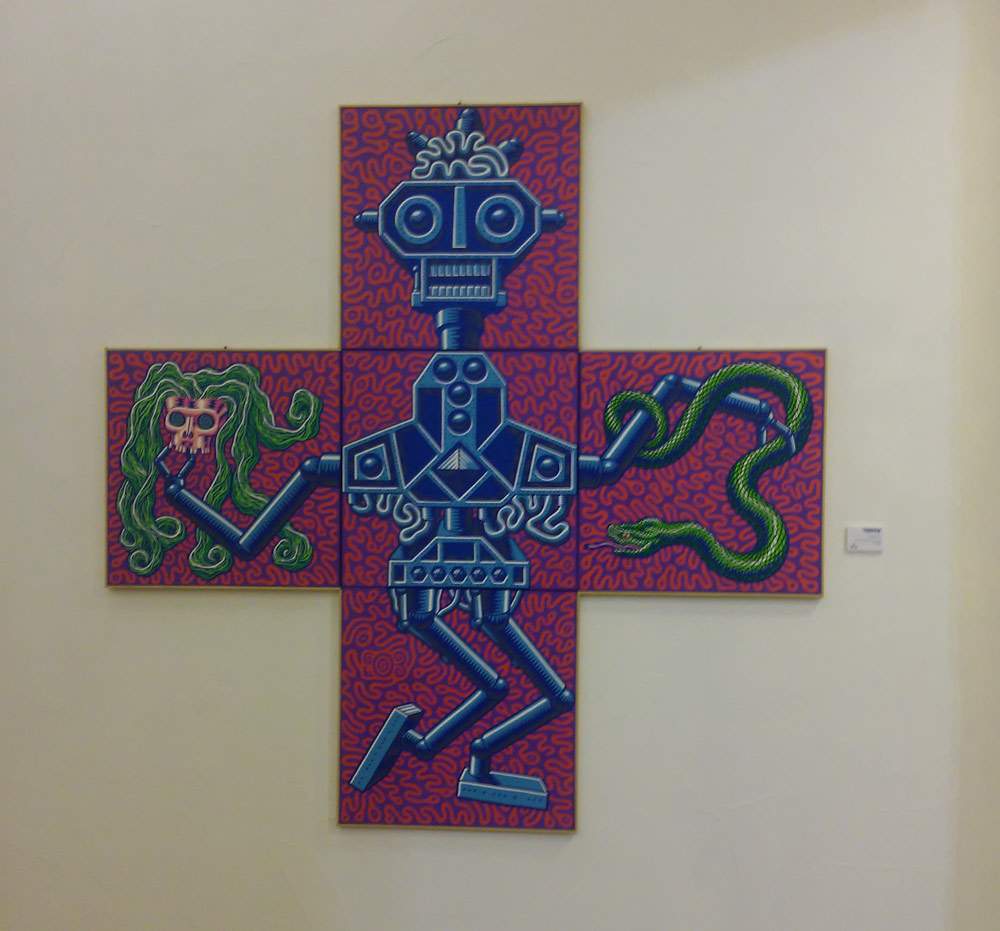 |
| Prof. Bad Trip, “Robota” (2003; five acrylics on canvas, 50 x 50 cm each) |
 |
| Prof. Bad Trip, “Lego Robot” (2004; lego bricks, 22 x 24 x 21 cm) |
All in a style rooted inpsychedelic art but also looking at pop art, the pop surrealism of Tod Schorr and Joe Coleman, contemporary cartoonists (such as Charles Burns and Savage Pencil), graffiti art (above all, the reference name is that of Keith Haring, to whom, moreover, the Professor has often been compared, although the La Spezia artist was more disenchanted than his American colleague). These are all experiences that merge in Prof. Bad Trip’s art giving life to works that probably have no equal in Italy, within the underground culture, for eclecticism and versatility.
A unique, anarchic, extremely sincere and outspoken artist: in the interview quoted above, he did not shy away from publicly calling newspapers such as La Nazione or Il Tirreno“bullshit newspapers,” or he did not hide his disappointment in complaining about how Mondadori (which for many would have been a point of arrival, and for the Professor instead had been a wasted opportunity) had treated his plates (badly paged, with bad printing and lacking information) in the anthology Almanacco apocalittico. An artist in the true sense of the word, capable of creating works that at the same time entertain, suggest experiences, give food for thought. Works that always move between reality, the unconscious, dreamlike journeys and lysergic visions. An artist, as Marco Cirillo Pedri wrote in his essay in the exhibition catalog, “has given us in his years of frenetic production an endless analysis of the profound change undergone by our society in the transition between the last two centuries,” and who is visionary in the true sense of the word, that is, “he succeeds in finding brilliant solutions that can change and make better the life of the entire community.”
Warning: the translation into English of the original Italian article was created using automatic tools. We undertake to review all articles, but we do not guarantee the total absence of inaccuracies in the translation due to the program. You can find the original by clicking on the ITA button. If you find any mistake,please contact us.